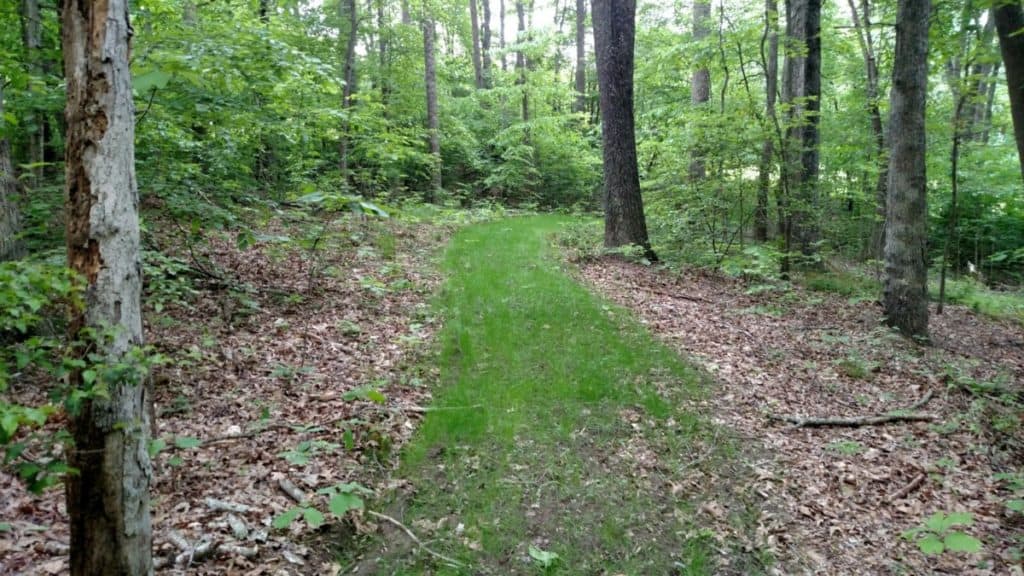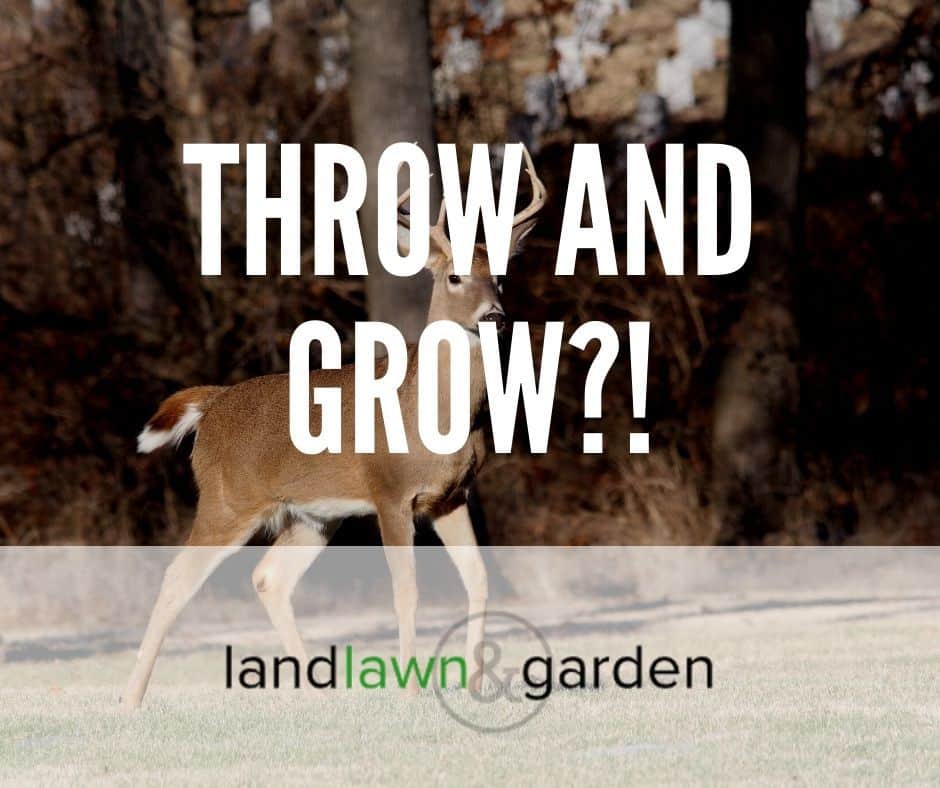Following the latest planting trends can drive a guy crazy with the food-plot craze still running full steam! But, it’s pretty simple; you need a realistic expectation, the right spot, and the right seed. There is an option called “throw and grow” food plot seed, but does it work?
“Throw and grow” seed mixes sold by wildlife companies effectively grow as promised. They usually consist of clovers, tetraploid ryegrass, and brassica. Most mixes contain more than 80% of ryegrass. Deer typically won’t eat ryegrass- it is low in nutrition and, in addition, difficult to eradicate.
Let’s see what throw and grow is and if “throw and grow” food plots actually work.
Quick Links
What Is Throw And Grow?

If you are part of a community hunting club or the wildlife industry, you’ll know that the term “throw and grow” is frequently used. For beginner wildlife enthusiasts, throw and grow is a term used for seeding where one doesn’t work and till the soil but walks about the plot and broadcasts the seeds over the ground.
The reason throw and grow seed food plots exist is that there are plot areas where it’s hard, sometimes even impossible, to get tillage equipment into the plot area.
No-till forage is selected to plant without having to use heavy equipment or disking. The no-till and throw and grow method will save you a lot of time and increase your planting options as more “out of reach” options become available.
What Seeds Are In Throw And Grow?
Many wildlife companies sell throw and grow seed mixes. These mixes contain three types of sweet forage, including clovers, tetraploid ryegrass, and brassica.
These forage types are specifically selected to give you a fast-growing food source filled with protein and minerals.
Let’s briefly look at each forage type.
Clover
Wildlife seed companies often mix clover into their blends because of their high protein levels throughout the hunting season.
Clover is relatively easy to grow, jammed with nutrition, and deer simply love it! A well-prepared and planted clover plot will produce two to four tons of clover per acre.
Clover also adds nitrogen into soil through its roots.
Clover seeds are minuscule and should never be planted through disking or other methods that will cover them in more than ¼ inch deep soil. So, these seeds are best spread through our previously mentioned “throw and grow” method.
Different types of clover:
- Arrowleaf Clover
- Alsike Clover
- Berseem Clover
- Crimson Clover
- Ladino Clover
- Red Clover

Tetraploid Rye Grass
Ryegrass is an annual crop that is hardy in most areas of the United States. Homeowners often overseed their summer season lawns to have a luscious green lawn through winter.
Due to its popularity, ryegrass is virtually available everywhere! Ryegrass establishes best during the fall, and you can already plant it in late August.
In addition, ryegrass is extremely easy to establish and works excellent on areas with poor soil, rough debris, or plot areas where sizeable tilling equipment is prohibited or can’t reach. This easy grow annual will grow by simply scratching the ground with a rake and putting the seed out.
Ryegrass is also a very adaptable grass that will grow in full sun or fairly heavy shade. It also germinates exceptionally quickly- you can have a huntable food plot within a week and a half after planting if you get timely rainfall.
For individuals with limited equipment and a shoestring budget, ryegrass might be just the ticket between having a food plot or not.
Brassica
Brassicas are considered cool-season forages and adapt well to cold weather. They produce a large amount of forage; you can expect two to four tons of forage per acre in a well-managed plot.
Brassica contains 25 to 35 percent protein and 15 percent fiber, making them nutritious and highly digestible. They are also most attractive to deer after a couple of frosts as the onset of colder weather triggers changes within the brassica plants and the whitetail’s metabolism (they need more carbs and fats).
Take caution in how much you seed the foot plot when planting brassica blends. The seeds are tiny, and when brassica seeds are spread too heavy, they compete for root space, moisture, and nutrients, causing a stunted field. So, my advice is to use a hand spreader.
Types of brassicas:
- Rape (most common)
- Kale
- Turnips
- Radish
Does Throw And Grow Food Plot Seed Work?
Many of the throw and grow seed mixes sold by wildlife companies effectively grow as promised. However, the catch twenty-two is that many of these seeds aren’t desired grass species for deer, or the seeds offer lower levels of nutrition.
For instance, annual ryegrass is often thrown into “throw and grow” mixes. And even though they rapidly germinate and look appealing to the eye, deer typically won’t consume most ryegrasses unless they have no other desirable species nearby.
Ryegrass is also low in nutrition and challenging to eradicate once established as it is a heavy re-seeder. Therefore, avoid planting ryegrass in plot areas where you eventually want to grow quality annual or perennial crops.
We also see that various poor clover types and forage species are added to “throw and grow” mixes.
For example, clovers like medium red and annual clover do better than standard ladino clover in shady areas or soils with a low pH and poor fertility. However, the mixes tend to only have the classic Ladino clover in the mix.
To be blunt- none of the commercial “throw and grow” mixes are any good or worth purchasing. For example, even though clover and brassicas have high protein and nutritional benefits, most commercial mixes have 80 percent or more ryegrass in them.
Companies do this to maximize profits because ryegrass is cheap. Therefore, they will grow pretty much anywhere, and people who purchase these seeds are usually first-timers looking for an easy solution.
What Throw And Grow Seed Mix Is Best For Deer?

If you are looking for a nutritious throw and grow and mix, you may want to make your own. Remember, using “throw and grow” seed mixes for cutting corners won’t work- you only get out as much as you put in.
Our recommended mix:
Rye- the cereal grain, not ryegrass! (30 pounds per acre)
Clover (6 pounds per acre)
Brassicas (4 pounds per acre)
Additionally, adding chicory to clover plots will hedge your dry and hotbeds.
Plant the mix in late summer to early fall on an area that gets a minimum of four hours of direct sunlight. For best results, prepare the food plot area by getting your soil testes, clear debris, logs, rocks, and weed, and apply lime and fertilizer.
Wrapping Up
To summarize, commercial “throw and grow” food plot seeds usually consist of three sweet forage types: clovers, tetraploid ryegrass, and brassica. However, most mixes contain more than 80 percent of ryegrass.
Ryegrass is low in nutrition, challenging to eradicate once established, and a heavy re-seeder. So, rather avoid the quick-fix commercial “throw and grow” seed mixes and consider making your mix including rye (not the grass), clover, and brassica.
In days busier than ever, having a self-made bag of throw and grow seeds will allow you to plant a last-minute food plot.

Kevin is the owner of Land Lawn & Garden. In addition to taking a lot of pride in his lawn at home, he also helps manage the family land. You can find more about him here.

